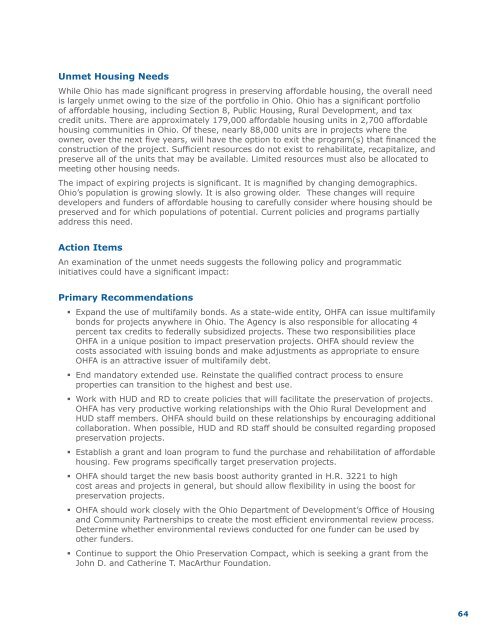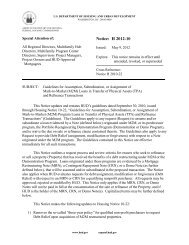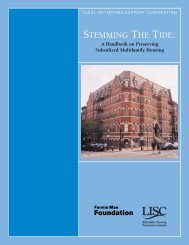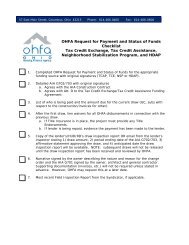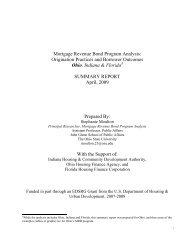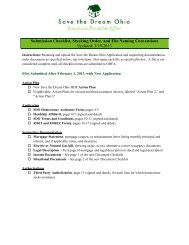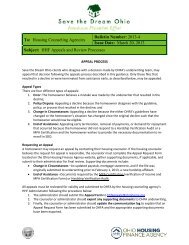OHFA Annual Plan - Ohio Housing Finance Agency
OHFA Annual Plan - Ohio Housing Finance Agency
OHFA Annual Plan - Ohio Housing Finance Agency
Create successful ePaper yourself
Turn your PDF publications into a flip-book with our unique Google optimized e-Paper software.
Unmet <strong>Housing</strong> NeedsWhile <strong>Ohio</strong> has made significant progress in preserving affordable housing, the overall needis largely unmet owing to the size of the portfolio in <strong>Ohio</strong>. <strong>Ohio</strong> has a significant portfolioof affordable housing, including Section 8, Public <strong>Housing</strong>, Rural Development, and taxcredit units. There are approximately 179,000 affordable housing units in 2,700 affordablehousing communities in <strong>Ohio</strong>. Of these, nearly 88,000 units are in projects where theowner, over the next five years, will have the option to exit the program(s) that financed theconstruction of the project. Sufficient resources do not exist to rehabilitate, recapitalize, andpreserve all of the units that may be available. Limited resources must also be allocated tomeeting other housing needs.The impact of expiring projects is significant. It is magnified by changing demographics.<strong>Ohio</strong>’s population is growing slowly. It is also growing older. These changes will requiredevelopers and funders of affordable housing to carefully consider where housing should bepreserved and for which populations of potential. Current policies and programs partiallyaddress this need.Action ItemsAn examination of the unmet needs suggests the following policy and programmaticinitiatives could have a significant impact:Primary Recommendations• Expand the use of multifamily bonds. As a state-wide entity, <strong>OHFA</strong> can issue multifamilybonds for projects anywhere in <strong>Ohio</strong>. The <strong>Agency</strong> is also responsible for allocating 4percent tax credits to federally subsidized projects. These two responsibilities place<strong>OHFA</strong> in a unique position to impact preservation projects. <strong>OHFA</strong> should review thecosts associated with issuing bonds and make adjustments as appropriate to ensure<strong>OHFA</strong> is an attractive issuer of multifamily debt.• End mandatory extended use. Reinstate the qualified contract process to ensureproperties can transition to the highest and best use.• Work with HUD and RD to create policies that will facilitate the preservation of projects.<strong>OHFA</strong> has very productive working relationships with the <strong>Ohio</strong> Rural Development andHUD staff members. <strong>OHFA</strong> should build on these relationships by encouraging additionalcollaboration. When possible, HUD and RD staff should be consulted regarding proposedpreservation projects.• Establish a grant and loan program to fund the purchase and rehabilitation of affordablehousing. Few programs specifically target preservation projects.• <strong>OHFA</strong> should target the new basis boost authority granted in H.R. 3221 to highcost areas and projects in general, but should allow flexibility in using the boost forpreservation projects.• <strong>OHFA</strong> should work closely with the <strong>Ohio</strong> Department of Development’s Office of <strong>Housing</strong>and Community Partnerships to create the most efficient environmental review process.Determine whether environmental reviews conducted for one funder can be used byother funders.• Continue to support the <strong>Ohio</strong> Preservation Compact, which is seeking a grant from theJohn D. and Catherine T. MacArthur Foundation.64


